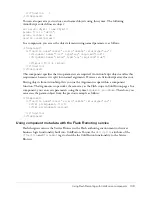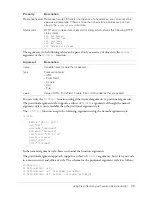
100
Chapter 6: Using Flash Remoting with ColdFusion MX
In your ColdFusion page, you access the parameter using
Flash.Params
, as shown in the
following example:
<cfquery name="flashQuery" datasource="exampleapps" >
SELECT ItemName, ItemDescription, ItemCost
FROM
tblItems
WHERE ItemName=
'#Flash.Params[1]#'
</cfquery>
<cfset Flash.Result=flashQuery>
Because ColdFusion converts an ActionScript data type to the corresponding ColdFusion data
type, you can perform CFML type-specific operations on the parameter. Therefore, if a parameter
passed from a Flash application is an ordered array, you can perform all CFML array operations
on the parameter.
For example, suppose you pass an array using the following ActionScript:
var array1 = new Array();
array1[0] = "zero";
array1[1] = "one";
myService.myMethod(array1);
You access the elements in the array in your ColdFusion page using ColdFusion array notation,
as follows:
<cfset arrayElement1=Flash.Params[1][1]>
<cfset arrayElement2=Flash.Params[1][2]>
Note:
Although ActionScript indexes start at 0, ColdFusion array indexes start at 1.
ActionScript also supports named (associative), arrays. These arrays have the following form:
var struct1 = new Array();
struct1["zero"] = "banana";
struct1["one"] = "orange";
myService.myMethod(struct1);
ColdFusion converts associative arrays into ColdFusion structures. To access the associative array
elements from
Flash.Params
, you use structure notation, as follows:
<cfset structElement1=Flash.Params[1].zero>
<cfset structElement2=Flash.Params[1].one>
Note:
You can use most of the CFML array and structure functions with ActionScript collections.
However, one CFML function,
StructCopy()
, does not work with ActionScript collections.
Содержание FLASH REMOTING MX
Страница 1: ...Using Flash Remoting for Flash MX 2004 ActionScript 2 0...
Страница 8: ...8 Contents...
Страница 62: ...62 Chapter 3 Using the RemotingConnector component Flash Professional only...
Страница 142: ...142 Chapter 7 Using Flash Remoting for Java...
















































